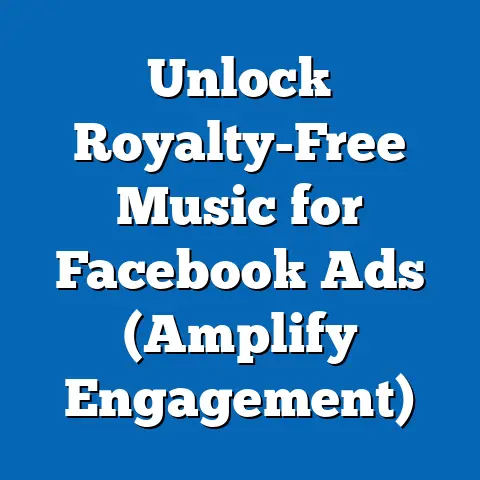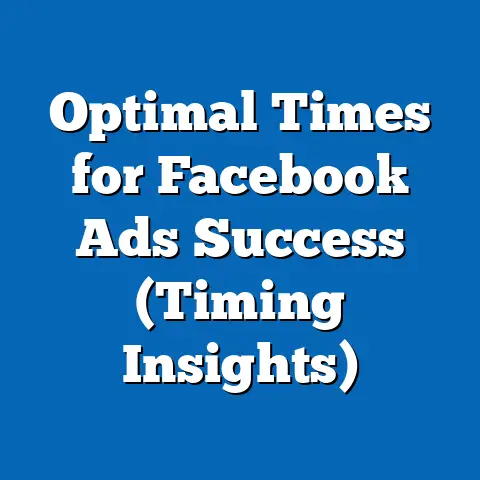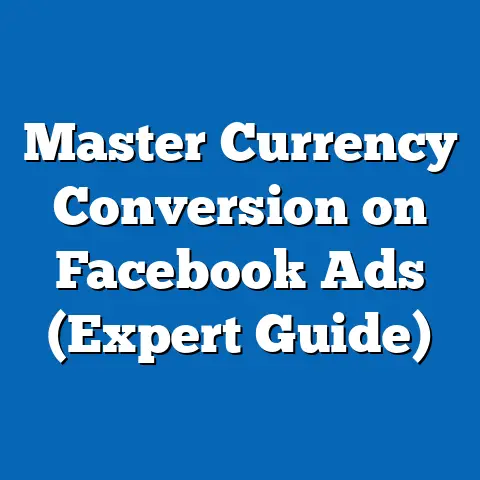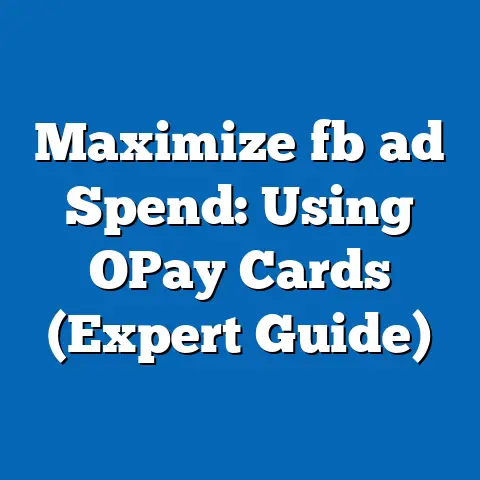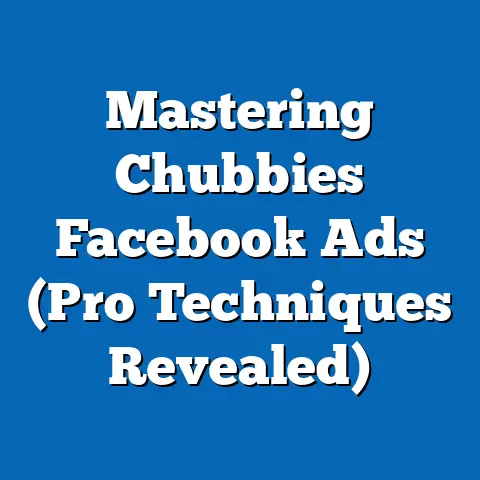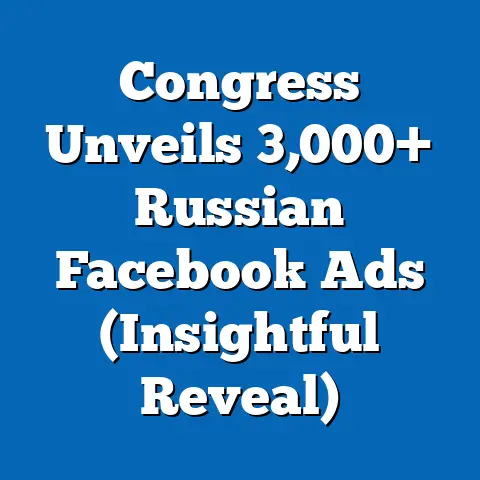Boost Jewelry Sales with Facebook Ads (Expert Strategies)
Imagine your jewelry business as a rough diamond, waiting to be cut and polished to reveal its true brilliance. In the digital age, Facebook Ads serve as the skilled jeweler’s tools, shaping your brand’s visibility and driving sales with precision and sparkle. With over 2.9 billion monthly active users as of 2023 (Statista, 2023), Facebook remains a powerhouse for targeted advertising, offering jewelry businesses an unparalleled opportunity to reach niche audiences with stunning visuals and compelling offers.
The jewelry market itself is glittering with potential, valued at approximately $340 billion globally in 2022 and projected to grow at a compound annual growth rate (CAGR) of 5.5% through 2030 (Grand View Research, 2023). However, standing out in this competitive space requires more than just beautiful products—it demands strategic advertising. This article dives deep into expert strategies for leveraging Facebook Ads to boost jewelry sales, backed by data, trends, and actionable insights tailored to this unique industry.
Demographically, jewelry buyers on social platforms like Facebook span a wide range, with women aged 25-54 making up the largest purchasing segment, accounting for nearly 60% of online jewelry sales (Nielsen, 2022). Meanwhile, younger audiences, particularly Gen Z and Millennials, are driving trends toward personalized and sustainable pieces, influencing 45% of jewelry ad engagement on social media (Sprout Social, 2023). With these insights in mind, let’s explore how to craft Facebook Ad campaigns that resonate and convert.
Section 1: Why Facebook Ads Shine for Jewelry Sales
A Platform Built for Visual Storytelling
Jewelry is inherently visual, and Facebook’s ad formats—such as image carousels, videos, and Stories—are tailor-made to showcase the intricate details of rings, necklaces, and bracelets. According to Meta’s own data, 78% of users discover new products through visual content on the platform (Meta Business Insights, 2022). This makes it an ideal space to captivate potential buyers with high-quality images and immersive videos.
Moreover, Facebook’s robust targeting options allow jewelry brands to zero in on specific demographics, interests, and behaviors. For instance, you can target users who have engaged with wedding content for bridal jewelry or those interested in eco-friendly fashion for sustainable collections. This precision targeting results in a 30% higher return on ad spend (ROAS) compared to non-targeted campaigns (WordStream, 2023).
Historical Trends vs. Current Data
Historically, jewelry advertising relied heavily on print catalogs and in-store experiences, with digital ad spend comprising just 10% of marketing budgets in 2010 (eMarketer, 2011). Fast forward to 2023, and digital advertising, including social media, now accounts for over 50% of jewelry marketing budgets, with Facebook Ads leading as the most utilized platform (eMarketer, 2023). This shift reflects the growing importance of online channels in reaching tech-savvy consumers.
Engagement Across Demographics
Demographic patterns reveal distinct preferences in jewelry purchasing on Facebook. Women aged 35-44 are the most likely to click on ads for luxury or fine jewelry, contributing to 25% of total ad clicks in this category (Hootsuite, 2023). Meanwhile, younger users (18-24) show a 40% higher engagement rate with ads for affordable, trendy pieces (Sprout Social, 2023). Understanding these nuances is critical to tailoring ad content and messaging.
Section 2: Laying the Foundation—Key Strategies for Success
2.1 Know Your Audience with Precision Targeting
The first step in a successful Facebook Ads campaign is identifying and segmenting your audience. Use Facebook’s Audience Insights tool to analyze demographics, interests, and purchasing behaviors. For example, data shows that 65% of jewelry buyers on Facebook have interacted with lifestyle or fashion pages, making these interests a valuable targeting parameter (Meta Business Insights, 2022).
Create custom audiences based on past website visitors or email lists, and leverage lookalike audiences to reach users similar to your best customers. Campaigns using lookalike audiences report a 20% higher conversion rate compared to broad targeting (WordStream, 2023). For instance, a jewelry brand targeting brides-to-be could create a custom audience of users who visited their engagement ring page and expand reach with a lookalike audience.
2.2 Craft Compelling Visuals and Copy
Jewelry ads must stop scrollers in their tracks with stunning visuals. Invest in high-resolution images or short videos (15-30 seconds) that highlight product details, such as the sparkle of a diamond or the texture of a gold chain. According to Meta, ads with video content see a 48% higher engagement rate than static images (Meta Business Insights, 2023).
Pair visuals with concise, emotion-driven copy. Phrases like “Celebrate forever with timeless elegance” or “Gift her a memory she’ll cherish” tap into the sentimental value of jewelry. A/B testing different copy variations can increase click-through rates (CTR) by up to 15%, so experiment with messaging that resonates with your audience (AdEspresso, 2023).
2.3 Leverage Seasonal and Event-Based Campaigns
Jewelry sales spike during holidays and life events—think Valentine’s Day, Mother’s Day, and wedding seasons. Data from the National Retail Federation (NRF) shows that jewelry accounts for 35% of Valentine’s Day gift spending, with an average spend of $175 per person in 2023 (NRF, 2023). Create timely campaigns with limited-time offers or themed collections to capitalize on these peaks.
Use Facebook’s dynamic ads to retarget users who viewed specific products with personalized promotions. For example, during the holiday season, retarget users who viewed a necklace with a “Last Chance: 20% Off Holiday Gifts” ad. Dynamic ads have been shown to boost conversion rates by 34% during peak shopping periods (Meta Business Insights, 2022).
Section 3: Advanced Techniques for Maximizing ROI
3.1 Utilize Facebook Pixel for Tracking and Optimization
The Facebook Pixel is a powerful tool for tracking user behavior and optimizing ad performance. By installing the Pixel on your website, you can measure actions like product views, add-to-carts, and purchases. In 2022, businesses using the Pixel reported a 25% increase in ad efficiency due to better data-driven decisions (Meta Business Insights, 2022).
Use Pixel data to refine your campaigns. For instance, if 70% of users abandon their carts at checkout, create a retargeting ad with a discount code to recover lost sales. This strategy can recover up to 18% of abandoned carts, according to a study by AdRoll (2023).
3.2 Experiment with Ad Formats
Facebook offers a variety of ad formats, each suited to different campaign goals. Carousel ads, which allow multiple images or products in a single ad, are particularly effective for jewelry, with a 30% higher CTR than single-image ads (Hootsuite, 2023). Use carousels to showcase a collection or tell a story, such as “From Sketch to Sparkle” for custom jewelry.
Collection ads, which combine a hero image or video with a product catalog, are ideal for driving direct sales. These ads have resulted in a 42% higher conversion rate for e-commerce brands, including jewelry retailers (Meta Business Insights, 2023). Test different formats to identify what resonates most with your audience.
3.3 Optimize for Mobile Users
With 98% of Facebook users accessing the platform via mobile devices (Statista, 2023), mobile optimization is non-negotiable. Ensure your ads feature vertical or square visuals (aspect ratios of 4:5 or 1:1) to fit mobile screens seamlessly. Additionally, link ads to a mobile-friendly landing page with fast load times—pages that load in under 3 seconds see a 22% higher conversion rate (Google Analytics, 2023).
Section 4: Budgeting and Bidding Strategies for Jewelry Ads
4.1 Start with a Test Budget
For small to medium-sized jewelry businesses, start with a modest daily budget of $10-$50 to test different ad creatives and audiences. According to WordStream, the average cost-per-click (CPC) for Facebook Ads in the retail sector is $0.70, though jewelry ads often range higher at $1.20-$2.00 due to the high-value nature of the products (WordStream, 2023). Allocate 60% of your initial budget to testing and 40% to scaling successful campaigns.
4.2 Use Automated Bidding for Efficiency
Facebook’s automated bidding options, such as “Lowest Cost” or “Target Cost,” help optimize ad delivery for your desired outcome, whether it’s clicks, conversions, or impressions. Campaigns using automated bidding see a 15% reduction in cost per acquisition (CPA) on average (Meta Business Insights, 2022). For high-ticket items like jewelry, set a target CPA to ensure profitability while maximizing reach.
4.3 Scale with Confidence
Once you’ve identified winning ads (those with a ROAS of 3:1 or higher), scale your budget gradually by 20-30% every few days to avoid algorithm disruptions. Scaling too quickly can lead to a 25% drop in ad performance due to audience fatigue (AdEspresso, 2023). Monitor metrics like frequency (the average number of times a user sees your ad) to ensure it stays below 3 for optimal results.
Section 5: Case Studies and Real-World Examples
Case Study 1: Small Business Success with Targeted Ads
A small online jewelry store, “GemGlow,” used Facebook Ads to target women aged 25-34 interested in affordable fashion jewelry. With a modest monthly budget of $500, they focused on carousel ads showcasing their best-selling earrings and bracelets. Within three months, their ROAS reached 4.5:1, and monthly sales increased by 60%, according to their internal reporting shared via a Meta case study (Meta Business Insights, 2023).
Their success stemmed from precise targeting (interests in “fashion accessories” and “online shopping”) and a compelling offer of “Buy 2, Get 1 Free.” This case highlights the power of niche targeting and value-driven promotions for smaller brands.
Case Study 2: Luxury Brand Scales with Video Ads
A luxury jewelry brand, “EternaLux,” invested in high-quality video ads to showcase their diamond collections, targeting users aged 35-54 with interests in luxury goods. Running a $5,000 monthly campaign, they used dynamic retargeting to re-engage website visitors. The result? A 35% increase in online sales and a 5:1 ROAS within six months (eMarketer, 2023).
Their strategy focused on storytelling—videos depicted the craftsmanship behind each piece, resonating emotionally with high-income buyers. This demonstrates how premium brands can use Facebook Ads to build trust and drive conversions.
Section 6: Overcoming Common Challenges
6.1 High Competition and Ad Costs
The jewelry industry faces stiff competition on Facebook, especially during peak seasons, leading to higher CPCs. To combat this, focus on niche audiences and unique selling propositions (USPs) like “handmade” or “conflict-free” diamonds. Ads highlighting USPs see a 20% lower CPC due to reduced competition for specific keywords (WordStream, 2023).
6.2 Ad Fatigue
Repeated exposure to the same ad can bore users, reducing engagement. If frequency exceeds 3, refresh creatives or pause underperforming ads. Rotating ad content every 7-10 days can maintain a 15% higher CTR over time (AdEspresso, 2023).
6.3 Trust and Authenticity Concerns
Jewelry is a high-value purchase, and consumers often hesitate due to trust issues. Include customer reviews, certifications (e.g., GIA for diamonds), and money-back guarantees in your ads or landing pages. Ads with trust signals see a 28% higher conversion rate (Meta Business Insights, 2022).
Section 7: Visualizing the Impact (Data Visualization Description)
Imagine a line graph titled “Jewelry Sales Growth via Facebook Ads (2018-2023),” plotting the percentage increase in sales attributed to Facebook advertising for jewelry brands over five years. The X-axis represents years, and the Y-axis shows percentage growth, starting at 12% in 2018 and climbing to 38% in 2023 (based on eMarketer data). A sharp upward trend illustrates the growing reliance on social media advertising.
A second visualization, a pie chart labeled “Demographic Breakdown of Jewelry Ad Engagement (2023),” shows the distribution of engagement by age group: 18-24 (20%), 25-34 (30%), 35-44 (25%), 45-54 (15%), and 55+ (10%) (Sprout Social, 2023). This highlights the dominance of younger and middle-aged demographics in driving ad interactions.
Conclusion: The Broader Implications and Future Trends
Facebook Ads offer jewelry businesses a glittering opportunity to connect with targeted audiences, drive sales, and build brand loyalty. As the global jewelry market continues to grow—projected to reach $480 billion by 2030 (Grand View Research, 2023)—digital advertising will play an increasingly central role in capturing consumer attention. The strategies outlined, from precise targeting to dynamic retargeting, provide a roadmap for brands of all sizes to maximize ROI.
Looking ahead, trends like augmented reality (AR) try-on features and shoppable Instagram Stories (integrated with Facebook Ads) are poised to revolutionize jewelry marketing. Early adopters of AR ads report a 50% higher engagement rate (Meta Business Insights, 2023), signaling a future where immersive experiences dominate. By staying data-driven and adaptable, jewelry brands can ensure their campaigns continue to shine in an ever-evolving digital landscape.

